

Grease Is The Word - Global Mining Review: Oct 2019
Posted on 04/17/20 in: Published Articles | | Mining | Author: Bret Jenkins, Michael Holloway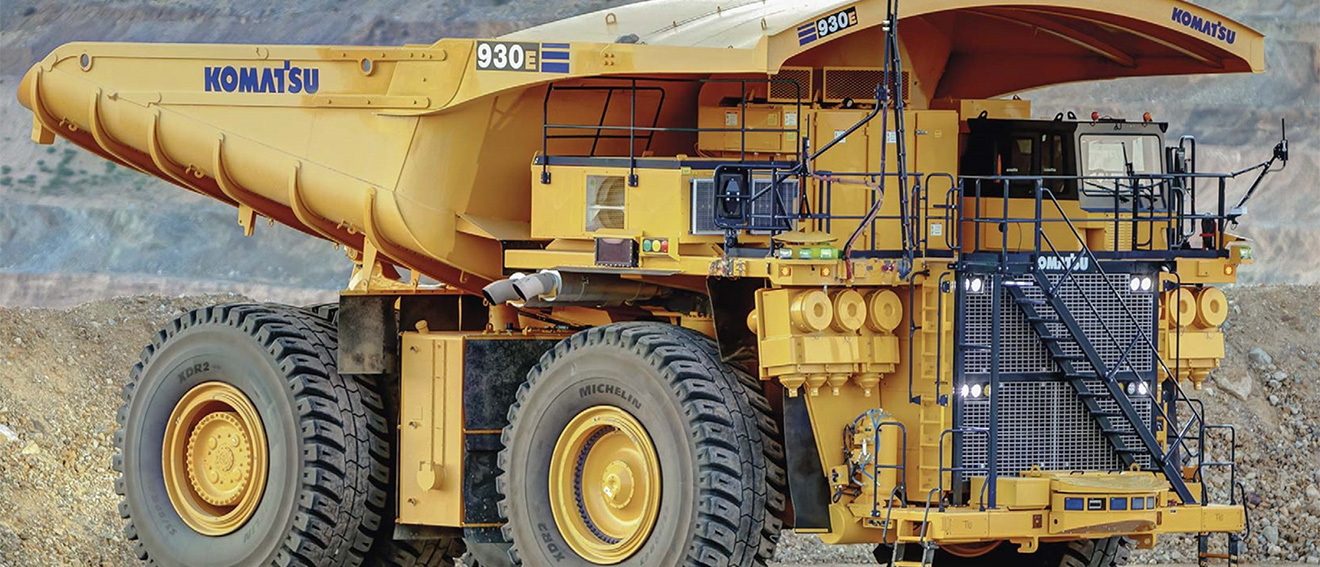
Bret Jenkins (Whitmore®/Jet-Lube®, USA) and Michael D. Holloway (5th Order Industry LLC, USA), explain how to determine which grease is best for your heavy equipment.
Many mining applications in various types of equipment can create a host of lubrication problems, including extreme heat, excessive pressure, water washout and contamination. All these problems can degrade grease and leave the components unprotected. A variety of grease technologies are available, designed to extend the operating life of different components and decrease downtime, parts replacement and labor costs. Greases are used to provide solutions to problems. If left unaddressed, these problems can manifest into equipment failure.
Most problems can be characterized into three main groups:
Excessive load and vibration: the vibration and force applied to a bearing or journal that exceeds the load carrying capability of the grease. The result is metal contact, premature wear and increased heat. This is often seen on bucket pins and bushings, as well as bearings on crushers.
Excessive and/or localized heat: operational heat that is generated during extended operation or localized heat that is generated as metal asperities collide, producing temperatures in excess of 2000 °F. The result is a breakdown of grease, cold welding or galling.
Contamination: sand, mud, water and steam can wash away grease, leaving metal unprotected. Dust, fibres and abrasive particles can combine with grease and grind away metal. Acids, caustics and cleaning solutions can break grease down and corrode metal. The result is a premature wear and grease breakdown.
Attempting to understand which grease is best for a given application can be a difficult task. Various controlled test methods have been established to make the selection process less painful. Many facilities use several different greases, often leading to costly misapplication mistakes. There has been a concerted effort to minimize the number of greases used in a facility; this technique is known as lubricant consolidation. Maintenance teams are in search of a few greases to take the place of several that are being used. After a grease is in service, it undergoes changes due to contamination and extreme conditions. There are several tests that have been developed that can determine the health of grease, and provide warning signs of impending bearing failure. These in-service tests can help identify misapplications, wear conditions, contamination and potential grease failure.
Lab Tests That Mimic Functional Problems
Many ASTM tests are effective at fundamentally understanding the performance of grease. These tests are run in a controlled environment in order to reduce variables and provide reproducible results.
Certain tests stand out as indicators of grease performance under specific circumstances. The selection of the following tests is the result of comparing the test results with actual applications. The greases that demonstrate the highest performance in the following tests have also been proven to provide the best protection, wear reduction and overall lubrication. These tests should serve to direct a decision and not be the deciding factor.
Four-Ball Weld and Wear, ASTM D-2596
This test calculates the measurements of greases' extreme pressure and wear protection ability in a dynamic environment (Figure 1). Three steel balls are placed at the bottom of the vessel. A test vessel is filled with the grease of interest. A fourth ball is held in with a chuck and forced onto the three balls. Load is applied to the fourth ball and turned. The load at which the balls begin to gall or seize is considered the weld point. The wear dynamic is the size of the scar that develops prior to seizing. The greater the weld numbers, the more stress the grease can withstand before the test specimens cold weld. The lower the wear scar value, the better protection the grease will provide while under dynamic stress. This is perhaps the best test method available for determining a lubricants ability to withstand load and protect from wear. Superior grease will have weld numbers above 600 kg and scar values below 0.50 mm.
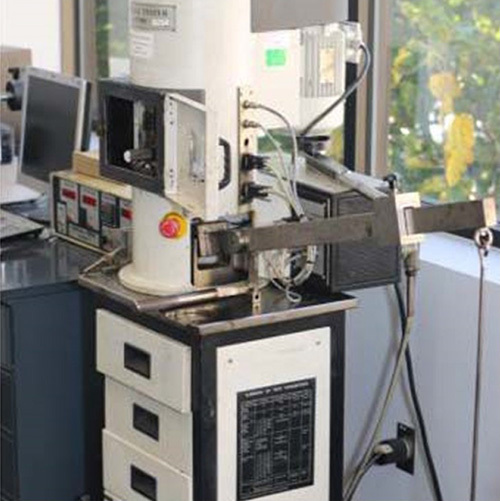
Figure 1. Four-ball test instrument.
Water Washout, ASTM D-1264
This test calculates the measurement of greases' resistance to washing out of a bearing. Grease is packed into the bearing and weighed (Figure 2). A cover plate is placed over the bearing housing. The bearing housing is then subjected to a water spray. After the exposure, the bearing housing with grease is dried, then weighed again. The difference of the weight is recorded. The lower the value, the less grease has washed out and the greater its resistance to water washout.
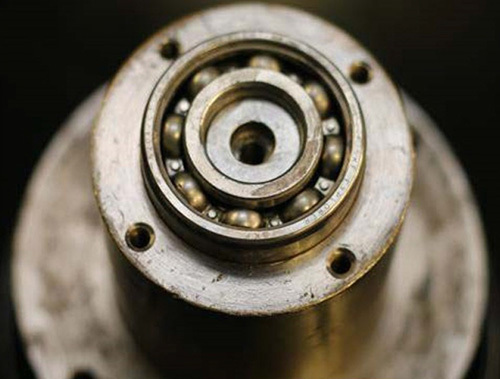
Figure 2. Bearing ready to be packed.
Dropping Point, ASTM D-2265
This test determines the temperature at which the grease changes from a semi-solid to a liquid. A sample of grease is placed in a small sample cup with a thermometer. The sample is placed in an oven. The temperature at which a drop comes out of the cup and falls to the bottom of the tube is the separation point. Clay-based (bentonite) grease, also known as non-melt grease, does not exhibit a dropping point. At temperatures above 500 °F, the base oil may evaporate, leaving behind an abrasive clay.
Worked Penetration (60 Strokes to 100,000), ASTM D 217, ASTM D 4950, ISO 6743-9
This test measures the change in the grease's consistency after it has been physically stressed. The test vessel (Figure 3) is filled with grease and a stress plate is screwed on to the vessel. The vessel is then placed on a stressing unit that 'works' the grease for a predetermined number of strokes. The consistency of the grease is then measured. Grease consistency can be measured using a grease penetrometer.
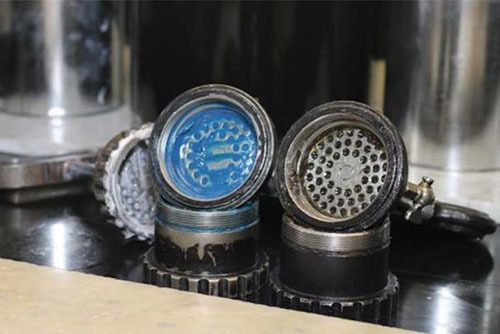
Figure 3. Test vessels work plate.
Grease Selection - Properties vs. Functionality
Selecting a grease for specific applications or selecting one grease to replace many is possible, if a disciplined approach is taken. The following steps can be used as a template for making an informed and accurate decision.
Environment - what will the equipment typically operate in?
- High or dry heat (above 150 °F).
- High or moist heat (above 150 °F).
- Low temperature (below 32 °F).
- Steam (direct or indirect).
- Submerged in water (fresh or salt).
- Sand, grit and loose dirt.
- Drastic temperature fluctuations.
- Acids, caustics and solvents.
Conditions - what are the operating conditions?
- Heavy loads.
- High speeds.
- Continuous shock.
- Dissimilar metals in the bearings, bushings and journals.
Also, consider the fact that if several different greases are being used at one facility, the chance of a misapplication is unavoidable. In certain cases, some greases may be incompatible. Mixing greases may create an immediate failure.
Table 1 compares various greases and their physical properties. The physical properties relate to various environments in the mine environment: water washout, extreme pressure, extreme scuffing and oil separation from the grease.
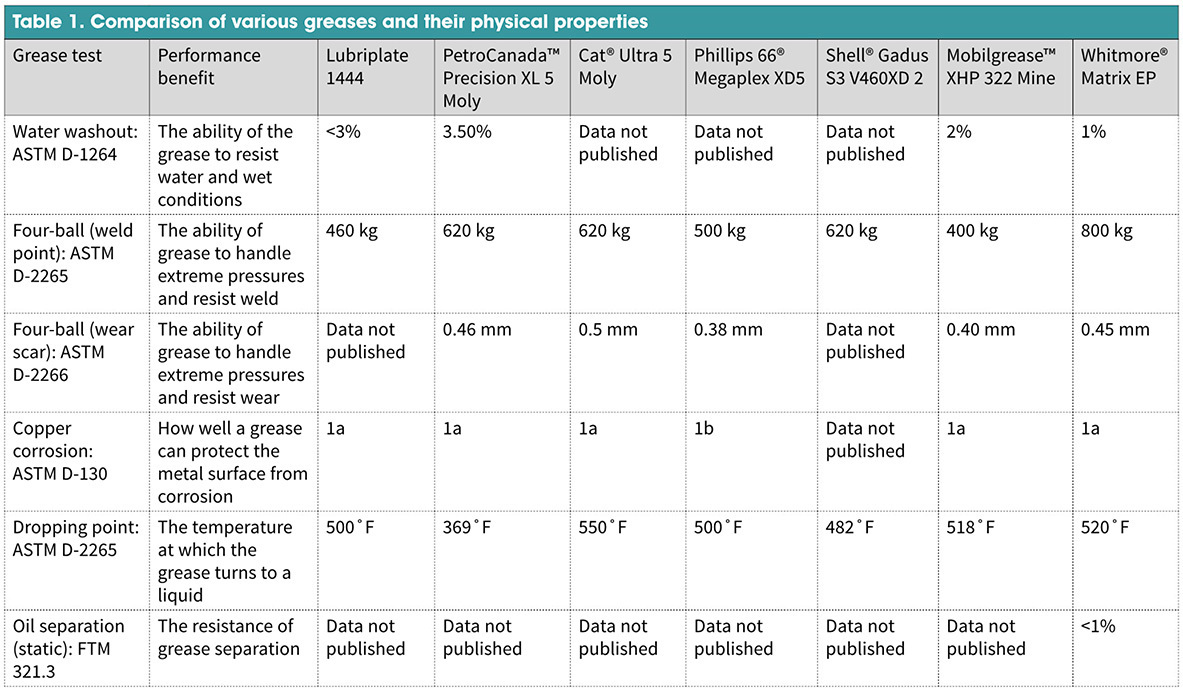
Conclusion
If most bearings fail due to wear and load, the four-ball test values will provide guidance in your grease selection. If the bearings fail due to lack of grease, yet proper grease frequency is being carried out, then water washout or melting could be occuring. The water washout data, as well as the dropping point, are important considerations. If the grease appears to have lost consistency, then the mechanical stability of the grease is in question and the worked penetration value must be considered.
Understanding the source of failure is very important when developing a purchasing case for grease. Having the technical information provided by the supplier and comparing the relationship of the performance to the known failure drivers will help to increase the equipment's reliability while driving down costs.